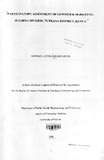| dc.description.abstract | A participatory study was conducted in Loima Division of Turkana District, Kenya, to
assess livestock marketing. It was aimed at generating information that could be used in
redesigning or modifying plans for viable livestock marketing interventions in the
division. The main objectives were: 1) to assess herders' perceptions on local markets; 2)
to assess herders' perceptions of cash income sources; 3) to determine existing livestock
marketed off-takes; 4) to assess herders' perceptions of livestock marketing constraints;
and 5) to determine herders' predictions of off-take levels ifmarkets were improved.
Four livestock camps (adakars) that included Natuba, Kicono, Acemie and Aporon were
conveniently selected for the study based on accessibility, security and logistics.
Selection of Loima Division as the study area was influenced by the existence of a
livestock marketing project that was under Veterinaries Sans Frontieres- Belgium (VSFB).
The study involved seventy-two (72) individual informants (herders) stratified on
gender and wealth, 16 informant groups of herders stratified on gender (each group had
8-15 people), fifty-nine (59) individual livestock traders (20 in 'lower' primary markets,
14 in 'upper' primary markets and 25 in secondary markets) and eight (8) government
livestock workers. Participatory Appraisal (PA) methods used in data collection included
seasonal migration maps, matrix scoring, proportional piling, simple ranking, seasonal
calendars, semi-structured interviews and workshops.
Potential livestock markets in the division were identified as Namoruputh, Lokiriama and
Lorengippi, with Namoruputh being proposed as central for establishment of an initial
livestock market. The herders classified traders based on tribe and marketing system of
operation of which the latter criterion clearly distinguished traders' preference than the
former. Traders were preferred based on their pricing of livestock, consistency in buying
livestock, trustworthiness, always with cash and friendly negotiations. The auction
system and organized marketing system with designated market days (based on personto-
person negotiation) were highly preferred as were traders operating in those systems.
Preference of a marketing system was based on livestock prices offered, cash availability,
attraction of buyers and sellers, and its frequency. The other systems of marketing were
traditionalsystem, mobile trader system and the shop system.
The two major sources of cash reported were from the sale of livestock and livestock
products (68%), and cash remittances from relatives and friends (13%). Commonly sold
species of livestock were goats, cattle, camels and donkeys of which goats emerged as the
primary source of cash (68%). Within the livestock holdings, sheep and goats (shoats)
constituted the largest proportion (60.9%) in the herds, followed by camels (17.9%) and
cattle (11.5%), with donkeys being the least (9.7%). Shoats constituted a higher
proportion of livestock in the herds among the poor whereas the proportion of large stock
was higher among the rich and medium class. Preference for selling different types of
stock was based on availability of buyers/market, season, availability in the herd,
magnitudeof familyproblem, wealth status and need for cash.
Most preferred age-sex categories for sale among goats, cattle and camels were mature
male castrates, except for donkeys where breeding males and females were sold. Mature
male castrates of goats, cattle, camels and donkeys were mostly sold during the dry
season whereas young animals of these species were sold throughout the year. Breeding
maleand female donkeys were mostly sold during the dry season.
Whereas producers gave high priority to low prices of livestock and traders perceived
low working capital as major problems affecting them in livestock marketing,
government livestock workers prioritized poor marketing infrastructure and lack of
marketing information as major problems that need to be addressed. When marketing
improves, herders were willing to sell livestock in proportions (30.4%) equal to that of
the current marketing system (30.5%). The proportional change in sales (difference
between sales before and after marketing improves) was negative for goats (-7.3%) and
positive for other types of livestock. Nonetheless, the proportion of goats (18.1%) to be
sold when marketing improves was still higher than that of the other livestock types
combined(12.3%).
Based on the results of this study, it is concluded that the pastoralists desire to participate
more actively in livestock markets but livestock marketing constraints are a hindrance.
They should therefore be involved in gathering and analyzing information to be used in
planning and designing best-bet interventions in livestock marketing. A further study is
recommended, to look at the root cause~ and effects of livestock marketing constraints
and analyze the various options for intervention; and to determine factors that would
influence pastoralists' desire to sustainably sell more livestock when marketing improves. | en |

